The EVGA GeForce GTX 1070 Ti FTW2 Review: iCX Brings the Lights and Sensors
by Nate Oh on January 31, 2018 9:00 AM EST- Posted in
- GPUs
- EVGA
- GeForce
- NVIDIA
- GTX 1070 Ti
Overclocking
Ultimately, the EVGA GTX 1070 Ti FTW2 is being pushed as an overclocking card, like the reference Founders Edition. The importance is clear for custom boards that may only run at reference clocks. To note, while NVIDIA does support overclocking, they have limited actual overvolting, and instead providing the ability to unlock 1-2 more boost bins and associated voltage points. In Precision XOC, this features as the percent voltage boost slider.
Precision XOC is already needed to fully utilize all iCX features, and by using it we were able to gauge the ‘software overclocking’ angle of the GTX 1070 Ti FTW2. In concrete numbers, running the Short Test resulted in offsets around +80 to +115MHz to the core clock, while running the Long Test resulted in a voltage curve with a maximum offset of +125MHz. The Long Tests occasionally crashed the ScannerX window, requiring user intervention to move on. One of the Short Tests applied a +114MHz offset, which we benchmarked. As neither OC test changes the power and temperature limits, the pseudo-overvoltage percentage boost, or even the maximum tested offset of +150MHz, we also benchmarked a manual overclock of +200MHz core and +200MHz memory offsets, with 120% power limit, 83 degree temperature target, and maximum voltage boost.
| EVGA GeForce GTX 1070 Ti FTW2 Overclocking | |||||
| Stock | Short Test Overclock | Manual Overclock | |||
| Core Clock | 1607MHz | 1721MHz | 1807MHz | ||
| Boost Clock | 1683MHz | 1797MHz | 1883MHz | ||
| Max Boost Clock | 1898MHz | 2012MHz | 2098MHz | ||
| Memory Clock | 8Gbps | 8Gbps | 8.8Gbps | ||
| Max Voltage | 1.062v | 1.062v | 1.093v | ||
| Power Limit | 180W | 180W | 217W | ||
Even that configuration does not represent the fullest mainstream overclocking capabilities of the GTX 1070 Ti FTW2. The maximum 235W power draw can only be accessed with a 130% power limit setting, something that is not available under the standard (master) BIOS. In any case, without knowing beforehand about EVGA Double BIOS on Pascal cards, it’s likely that a user will not understand that the maximum 235W power draw specification needs to be enabled.
In the case of the GTX 1070 Ti FTW2, toggling to the secondary (slave) BIOS raises the power limit to 130%, raises the temperature target to 93 degrees, applies a more aggressive fan curve, and disables zero fan speed idle. As EVGA notes, the Pascal architecture will reduce clockspeeds once the GPU core temperature reaches 60 degrees, so for the maximum mainstream overclock a very aggressive fan curve should be applied. For the curious, we were able to reach past 2100MHz by using the slave BIOS.
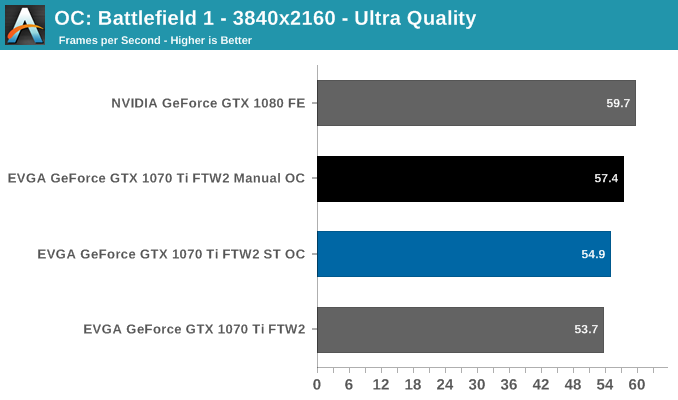

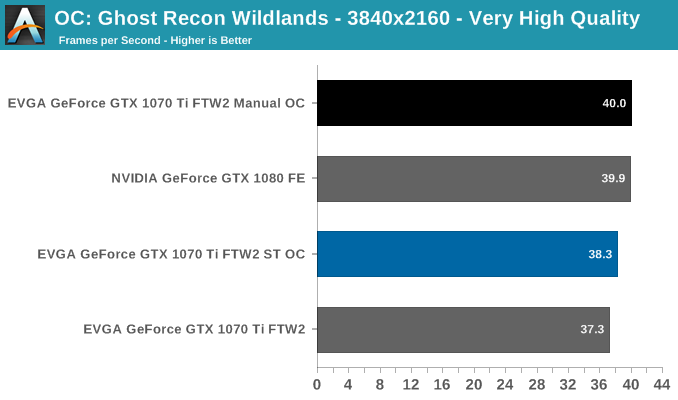
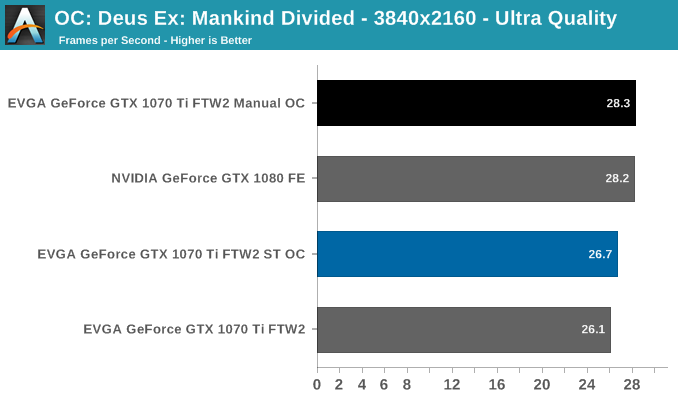

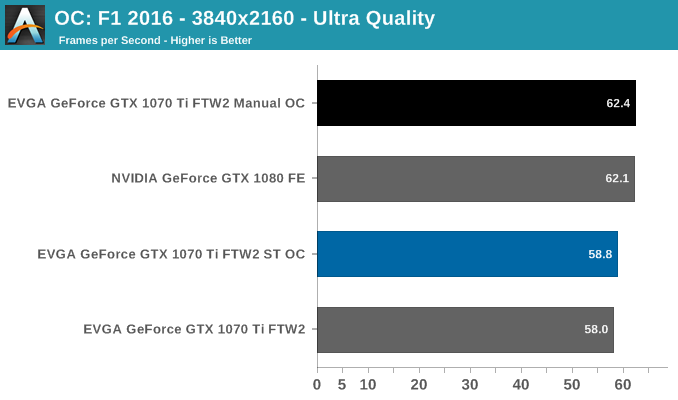
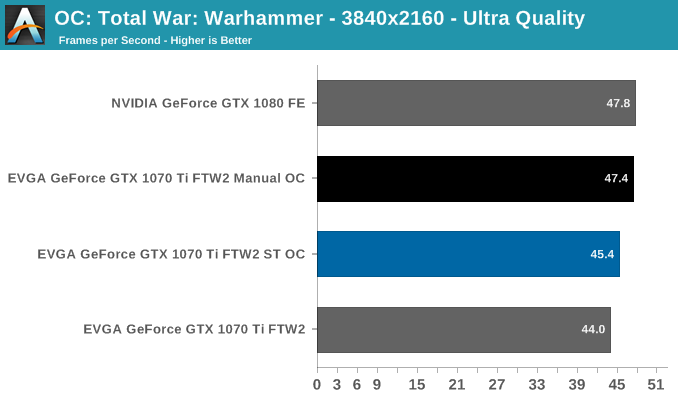
As always with overclocking, individual GPU dies behave differently and a sample size of one is not representative of all models. Nevertheless, the performance increases are in line to what we saw with overclocking the GTX 1070 Ti Founders Edition. The capability to perform at the level of a GTX 1080 definitely exists. And as a case study of EVGA’s new-ish single-step overclocking solution, we can see that Precision XOC applies a mild overclock that can be accomplished without relatively riskier changes to power/temperature limit or voltage boost. This carries through to the power, temperature, and noise aspects, which are equally as tame as the Short Test overclock.

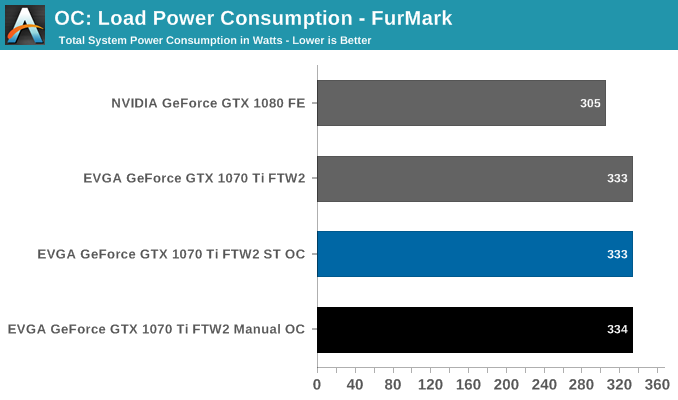
That being said, our XOC Scanner auto-overclocks act better as a selling point than a perceptible performance increase; in our results, framerates increased by an average of 2%. Now, it is true that a good amount of factory overclocked graphics card have only token clockspeed increases, if only just to say that it’s overclocked, something that is not possible for the GTX 1070 Ti series. Even if higher software-enabled clockspeeds are advertised, the software itself is more-or-less optional. Whereas, independent from overclocking, the GTX 1070 Ti FTW2 iCX needs Precision XOC to truly – and literally, for that matter – shine. So in that sense XOC Scanner nonetheless provides the GTX 1070 Ti FTW2 iCX the closest thing to a common factory-esque overclock than its peers.










47 Comments
View All Comments
Dr. Swag - Wednesday, January 31, 2018 - link
Oh cool! Anandtech finally reviews some aftermarket gpus!If only we could actually, you know, buy them.
sharath.naik - Wednesday, January 31, 2018 - link
Whats with the gpu prices?!! I had bought 1080 ti for 660$ 8 months back, today its 1400$+, when trying to get a second one.Hereiam2005 - Wednesday, January 31, 2018 - link
I bought mine last week for 750$. Its a shitty 1080ti, the gigabyte gaming oc version, but it is much cheaper than other models.Dr. Swag - Wednesday, January 31, 2018 - link
Miners.JoeyJoJo123 - Wednesday, January 31, 2018 - link
Supply/Demand.People are pointing the finger at miners, but it's more than just an alternative coin mining issue. AIB partners are hesitant to make more cards because the last time GPU mining was big, GPU AIBs mostly sought to meet bigger supply to the bigger demand, only to get burned three-ways.
1) Bitcoin market crashed. This led to GPU demand faltering quickly.
2) They had already made their quarterly order to AMD/nVidia and were stuck with excess GPUs which they couldn't sell due to:
a) Miner card resale market providing cheaper cards to those at lower price brackets.
b) Lack of miner demand which the increased supply was supposed to meet.
c) New GPU architecture releasing the next quarter, while they were still stuck on lots of old GPUs.
3) Excess of warranty claims for excess GPU supply to miners.
AIB partners would be willing to increase their quarterly orders so as to increase GPU supply to meet increased demand (due to miners) if they could _assume_ stability in the demand, which fundamentally means assuming stability in the crypto market, but stability in the crypto market is a complete and utter joke, so they're not willing to increase supply especially if next-gen GPUs might be around the corner if AMD/nVidia have an announcement by next quarter (GTX1100 series, RX600 series, etc.)
JoeyJoJo123 - Wednesday, January 31, 2018 - link
Also, GPU pricing is also being affected by 3rd party sellers wanting to take advantage of the mining demand. 3rd party marketplace sellers on Amazon marketplace, Newegg marketplace, and eBay are also scalping excess GPU stock not to mine, but just to resell to gamers willing to fork over the money, but particularly to miners which can still recoup on the purchase, but will face a longer return on investment.Don't buy from 3rd party marketplace scalpers, they're just as guilty as miners (if not moreso, as they have no intent to even open the GPUs to use them for themselves) for draining supply from 1st party sellers, which prevents folk like you from getting rational prices.
Just wait for next gen cards, maybe. AIBs won't be shy to ramp up production of the newest stuff that miners and gamers will be sure to buy and can guarantee they won't be sitting on outdated stock.
Pinn - Wednesday, January 31, 2018 - link
Nvidia has volta, but AMD has nothing next-gen for awhile.VulkanMan - Wednesday, January 31, 2018 - link
AMD has Navi.CiccioB - Thursday, February 1, 2018 - link
Coming in 2019FreckledTrout - Wednesday, February 7, 2018 - link
AMD have Vega on 7nm coming this year. I wouldn't brush the move to 7nm off either is it should allow the GCN architecture to breath by hitting much higher clocks. Of course the proof is in the pudding but I expect the 7nm shrink to be a decent performance bump.